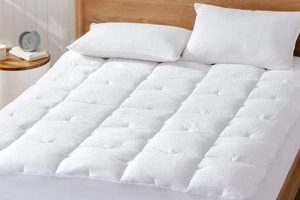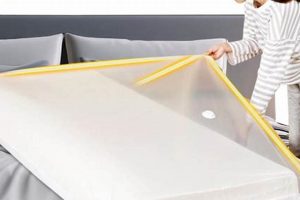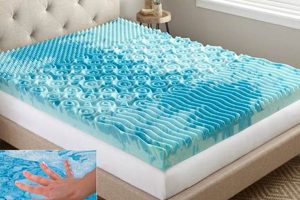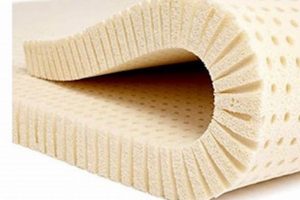A portable layer designed to enhance the comfort of sleeping surfaces used in outdoor environments. Typically constructed from materials like memory foam, down, or synthetic fills, it is placed atop a camping mattress or sleeping pad to provide additional cushioning and insulation. These additions serve as supplementary layers to a sleeping system.
The significance of such an item lies in its ability to improve sleep quality during camping trips. Enhanced comfort translates to better rest, which is crucial for physical recovery and enjoyment of outdoor activities. Historically, campers relied on rudimentary bedding; modern iterations represent a significant advancement in outdoor comfort technology, providing lightweight and packable solutions.
The subsequent discussion will explore various types, materials, features, and considerations when selecting an appropriate product to augment camping sleep arrangements. Factors influencing purchase decisions, such as weight, size, insulation value, and cost, will also be examined.
Enhancing Sleep with a Camping Mattress Topper
Optimizing the camping experience hinges on adequate rest. A crucial element in achieving this is the careful selection and utilization of a sleeping system that incorporates a camping mattress topper. The following guidance offers practical advice for maximizing its benefits.
Tip 1: Prioritize Compactness and Weight: Assess the packed size and weight relative to carrying capacity. A bulky, heavy option negates the advantages of lightweight camping gear. Models that compress significantly are preferable.
Tip 2: Evaluate Insulation Properties: Consider the R-value, if provided. Insulation performance is essential in colder climates, retaining body heat and preventing conductive heat loss to the ground. Layering with blankets is also beneficial.
Tip 3: Select Material Based on Durability: Different materials offer varying degrees of resistance to wear and tear. Robust materials, such as high-density foam or durable synthetic fabrics, withstand frequent use and rough terrain better.
Tip 4: Match Size to Existing Mattress or Pad: Ensuring proper fit minimizes shifting and maximizes comfort. Overhanging or undersized options may create uneven surfaces.
Tip 5: Consider Ease of Cleaning: Camping environments often lead to soiling. A model with a removable, washable cover simplifies maintenance and hygiene.
Tip 6: Assess Compatibility with Sleeping Bag: Matching the topper’s surface material to the sleeping bag’s lining improves sleep experience. Certain combinations cause excessive slippage, disrupting sleep.
Tip 7: Test Before Committing: If possible, test the topper on the intended mattress or pad before venturing into the field. This provides an opportunity to assess comfort and identify any potential issues.
Employing these strategies results in a more comfortable and restorative sleep experience during camping excursions. Proper application ensures effective use, fostering improved outdoor experiences.
The subsequent section will delve into specific product reviews and comparisons, further aiding in the selection process.
1. Comfort
Comfort is a primary determinant of sleep quality within the context of outdoor recreation. A camping mattress topper directly addresses this factor by adding a layer of cushioning and support to the typically firm and uneven surfaces encountered in camping environments. The absence of adequate comfort contributes to disrupted sleep, resulting in fatigue, reduced physical performance, and diminished enjoyment of outdoor activities. For instance, without sufficient padding, pressure points on the hips and shoulders can cause discomfort and awakenings throughout the night, negating the restorative benefits of sleep.
The materials used significantly affect comfort. Memory foam conforms to the body’s contours, distributing weight evenly and reducing pressure points. Down and synthetic fills offer a softer, more compliant surface compared to the bare ground or a thin sleeping pad. The thickness and density of the topper also play crucial roles. A thicker, higher-density topper offers greater cushioning and support, suitable for individuals who prioritize comfort over portability. Conversely, a thinner, less dense option might be preferable for those seeking to minimize weight and bulk. Real-world examples demonstrate that individuals with back pain or other orthopedic concerns often find substantial relief using such sleeping arrangements.
In conclusion, comfort is not merely a desirable attribute but an essential component in a functional camping sleep system. The integration of a strategically chosen item directly impacts the quality of rest achieved, influencing physical recovery and overall outdoor experience. While trade-offs between comfort, weight, and cost must be considered, prioritizing comfort is paramount for campers seeking to maximize the benefits of their time spent in nature.
2. Portability
Portability represents a critical attribute in the context of camping equipment, including the design and selection of a camping mattress topper. The inherent limitations on pack space and weight capacity during outdoor excursions necessitate careful consideration of this factor. The trade-off between comfort and ease of transport frequently dictates product choices.
- Packed Size
The volume occupied by a topper when compressed or folded significantly impacts its portability. Larger, bulkier models consume valuable pack space, potentially limiting the amount of other essential gear that can be carried. Manufacturers employ various compression techniques and materials to minimize packed size, offering solutions ranging from rollable foam pads to self-inflating designs. For example, a backpacking trip emphasizing minimalist packing requires a drastically smaller and lighter topper than a car-camping scenario where space is less constrained.
- Weight
The mass of the topper directly contributes to the overall weight burden carried during a camping trip. Excessive weight can lead to fatigue, reduced mobility, and increased risk of injury, particularly during long-distance hikes. Materials like lightweight memory foam and compressible synthetic fills are often employed to minimize weight without sacrificing a substantial degree of comfort. Consider, for instance, the difference between a traditional innerspring mattress topper, wholly unsuitable for camping due to its weight, and a lightweight, inflatable option designed specifically for backpacking.
- Carry Method
The means by which a topper is transported affects its overall portability. Some models feature integrated carrying straps or compression sacks, facilitating attachment to backpacks or securing within vehicles. Others necessitate separat
e storage solutions, potentially adding complexity and inconvenience to the packing process. Backpackers may prefer toppers that can be externally attached to their packs, freeing up internal space, whereas car campers might prioritize ease of loading and unloading without regard to external carry features. - Durability vs. Weight Compromise
The pursuit of lightweight portability can sometimes compromise durability. Ultra-light materials are often more susceptible to damage from abrasion, punctures, or compression, potentially shortening the lifespan of the topper. Striking a balance between weight reduction and material robustness is essential for ensuring the product can withstand the rigors of outdoor use. For example, a very thin, lightweight inflatable topper may be prone to punctures on rough terrain, while a heavier, more durable model offers greater protection but adds to the overall weight carried.
The intersection of these aspects ultimately defines the practical portability of a camping mattress topper. Selecting a product requires a comprehensive assessment of trip-specific needs, balancing the desire for enhanced comfort with the imperative of minimizing weight and bulk for manageable transport. Overriding any choice must align with the intended outdoor activity and available carrying capacity.
3. Insulation
Insulation is a critical performance parameter of a camping mattress topper, directly influencing the retention of body heat and mitigating conductive heat loss to the ground. The degree of insulation provided dictates the suitability of the topper for use in varying environmental conditions. A topper with inadequate insulation can lead to significant heat loss, resulting in discomfort, disrupted sleep, and potentially, hypothermia in extreme cold. The cause-and-effect relationship is linear: diminished insulation equates to increased heat dissipation. The importance of insulation is amplified in colder climates or during shoulder seasons when ambient temperatures drop significantly overnight. For instance, in winter camping scenarios, a topper lacking sufficient thermal resistance offers little benefit, as the sleeping individual’s body heat is rapidly transferred to the colder ground.
The construction materials and design of a camping mattress topper dictate its insulation capabilities. Materials such as closed-cell foam, down fill, and synthetic insulation provide varying degrees of thermal resistance, quantified by an R-value. A higher R-value signifies greater insulation. Closed-cell foam, characterized by its dense structure and resistance to compression, offers a stable level of insulation even when wet. Down fill, while providing excellent warmth-to-weight ratio, loses its insulation properties when damp. Synthetic insulation maintains its insulation capability to a greater extent when exposed to moisture. Real-world examples showcase that campers utilizing closed-cell foam toppers in wet or snowy conditions experience a more consistent level of warmth compared to those using down-filled alternatives.
In summary, insulation represents an indispensable element in a camping mattress topper, directly impacting user comfort and thermal regulation. The choice of materials and design directly influence insulation performance, with measurable R-values serving as a benchmark for evaluation. While factors such as weight and packability are important considerations, neglecting insulation can compromise the user’s well-being and detract from the overall camping experience. Thus, a clear understanding of insulation properties is essential for making informed purchasing decisions.
4. Durability
The endurance of a camping mattress topper under the rigors of outdoor use directly determines its long-term value. Exposure to abrasive surfaces, fluctuating temperatures, moisture, and repeated compression cycles presents significant challenges to material integrity. A lack of durability precipitates premature failure, necessitating frequent replacement and increasing overall expenditure. For instance, a topper constructed from thin, easily torn fabric may succumb to damage from rocks or tree roots, rendering it unusable after only a few camping trips. The practical consequence is a compromised sleep surface and the added cost of purchasing a replacement, thereby negating any initial cost savings.
Material selection and construction techniques are the primary drivers of durability. High-denier fabrics, reinforced stitching, and waterproof coatings contribute significantly to resistance against wear and tear. The type of foam or fill used also plays a crucial role; closed-cell foams generally exhibit greater resilience than open-cell varieties, and synthetic fills tend to be more resistant to degradation from moisture compared to down. Field testing demonstrates that toppers incorporating these features consistently outperform their less robust counterparts in terms of longevity and continued performance under demanding conditions. Therefore, informed purchasing decisions should prioritize materials and construction known for their durability, aligning with the anticipated frequency and intensity of use.
In summation, durability constitutes a critical, non-negotiable attribute of a camping mattress topper. Its influence extends beyond mere product lifespan, impacting user comfort, long-term cost-effectiveness, and environmental sustainability. While initial price points may be tempting, prioritizing durable materials and construction ensures sustained performance and reduced long-term expenses. Thus, durability should be a central consideration when selecting a camping mattress topper, ensuring it can withstand the demands of the outdoor environment and provide reliable comfort for numerous camping expeditions.
5. Compatibility
The successful integration of a camping mattress topper hinges upon compatibility with various components of the camping sleep system and external factors. Proper alignment across these elements ensures optimal performance and user satisfaction.
- Mattress or Sleeping Pad Dimensions
Dimensional congruence between the topper and the underlying sleeping surface is essential. A mismatch can lead to instability, uneven weight distribution, and discomfort. An oversized topper may overhang, creating trip hazards, while an undersized one provides inadequate coverage. Manufacturers typically specify dimensions; adherence to these specifications ensures a secure and functional fit. Mismatched dimensions negate the intended ergonomic benefits.
- Sleeping Bag Type and Material
The surface texture of the topper influences its interaction with the sleeping bag. Certain combinations of materials, such as a smooth topper surface paired with a slick sleeping bag lining, may result in excessive slippage during sleep. Conversely, textured surfaces can provide better grip. This aspect is crucial for preventing sleep disruption caused by constant readjustment. Some materials also tend to generate more friction. A material that generates friction might be preferred by some campers.
- Tent Floor Material and Size
The characteristics of the tent floor, including its material compositio
n and dimensions, affect the placement and stability of the sleeping system. A waterproof tent floor mitigates moisture absorption into the topper, while sufficient tent floor space prevents overcrowding and compression of the sleeping system. Overcrowding can lead to excessive wear and tear, diminishing longevity. - User Preferences and Physical Characteristics
Individual sleep preferences and physical attributes, such as body weight and sleeping position, influence the perceived comfort and support provided by the topper. A heavier individual may require a denser, more supportive topper, while a side sleeper benefits from enhanced cushioning in the shoulder and hip areas. Failure to accommodate these factors can compromise sleep quality.
The aforementioned compatibility aspects represent interconnected variables requiring careful consideration when selecting a camping mattress topper. A holistic approach ensures synergistic integration, maximizing comfort, performance, and durability within the context of the overall camping environment. The result is a better rest which leads to more enjoyment of outdoor experiences.
6. Maintenance
The longevity and sustained performance of a camping mattress topper are intrinsically linked to consistent and appropriate maintenance practices. Neglecting proper care leads to accelerated degradation of materials, diminished comfort, and increased susceptibility to microbial growth. The cause-and-effect relationship is clear: insufficient maintenance directly precipitates a reduction in the topper’s functional lifespan and hygienic qualities. Maintenance encompasses various activities, including cleaning, drying, and proper storage. These practices mitigate the accumulation of dirt, moisture, and mold, all of which can compromise the integrity of the topper’s internal structure and surface materials. A failure to address these elements results in a breeding ground for bacteria and allergens, presenting potential health risks to the user. In the practical realm, neglecting to dry a memory foam topper after exposure to moisture can lead to irreversible compression and loss of its conforming properties. Therefore, incorporating proactive maintenance routines is essential for preserving the topper’s value and ensuring a sanitary sleeping environment.
Specific maintenance procedures vary depending on the topper’s construction materials. Memory foam models often require spot cleaning with mild detergents and thorough air drying to prevent moisture retention. Down-filled options necessitate professional cleaning to avoid damaging the delicate feathers. Synthetic-filled toppers are generally more resilient and can withstand machine washing and drying, albeit with specific temperature and cycle settings. Regular inspection for tears, punctures, or seam separation is crucial for identifying and addressing minor issues before they escalate into major problems. Protective storage bags or containers prevent dust accumulation and physical damage during periods of non-use. As an example, storing a rolled-up topper in a dry, climate-controlled environment prevents the growth of mold and mildew, thereby extending its usable life.
In conclusion, maintenance represents a fundamental component in maximizing the lifespan and hygienic integrity of a camping mattress topper. Diligent adherence to recommended cleaning, drying, and storage protocols mitigates material degradation and safeguards user health. The implementation of these practices ensures that the topper consistently provides a comfortable and sanitary sleeping surface throughout its intended lifespan. By embracing a proactive maintenance approach, campers can realize the full value of their investment and minimize the need for premature replacement, thereby contributing to both economic and environmental sustainability.
7. Cost
The price point of a camping mattress topper significantly influences its accessibility and purchase feasibility for prospective consumers. Cost functions as a primary determinant in the decision-making process, often weighing against competing factors such as comfort, durability, and portability. Lower-priced models may offer a basic level of cushioning, but frequently compromise on material quality, insulation, and overall lifespan. Conversely, higher-end options typically incorporate premium materials and advanced construction techniques, yielding enhanced comfort and durability, albeit at a greater financial investment. A real-world example involves the choice between a budget-friendly, open-cell foam topper with limited longevity and a more expensive, closed-cell foam alternative known for its resistance to compression and moisture damage. The immediate cost savings of the former may be offset by the need for frequent replacements, thereby negating the initial financial advantage.
The composition of materials and manufacturing processes exert a considerable effect on the final cost. Toppers utilizing memory foam, down, or specialized synthetic insulation typically command a higher price due to the inherent expense of these materials and the complexity of their processing. Furthermore, features such as waterproof coatings, reinforced stitching, and integrated carrying systems contribute to the overall cost. Practical application reveals that campers undertaking frequent or extended trips may find the investment in a more durable, albeit pricier, topper to be economically justifiable in the long run. This is due to the reduced likelihood of needing replacements and the potential for enhanced sleep quality, leading to improved physical recovery and overall enjoyment of the outdoor experience. Some may weigh in the value of a brand as well.
In summation, cost represents a crucial and multifaceted consideration in the context of camping mattress toppers. While budget constraints invariably influence purchasing decisions, a purely cost-driven approach may result in the selection of a product that fails to meet long-term needs or withstand the rigors of outdoor use. Therefore, a balanced assessment that considers not only the initial price point but also the long-term value, durability, and performance characteristics is essential for making an informed and economically sound choice, also with a bit of research, there are discounts such as coupons.
Frequently Asked Questions
This section addresses common inquiries regarding camping mattress toppers, providing definitive answers and clarifying potential misconceptions.
Question 1: What constitutes a camping mattress topper, and how does it differ from a standard mattress topper?
A camping mattress topper is a portable bedding accessory designed to augment the comfort and insulation of sleeping surfaces used in outdoor environments. Unlike standard mattress toppers, which are typically bulky and intended for stationary use, camping versions prioritize lightweight construction, compact pack size, and durability. These are designed to be easily transported and withstand the rigors of outdoor use.
Question 2: What are the primary materials used in the construction of a camping mattress topper, and what are their respective advantages and disadvantages?
Common materials include memory foam, down, and synthetic fills. Memory foam provides conforming support and pressure relief but can be heavier and less breathable. Down offers excellent insulation and compressibility but loses its insulating properties when
wet. Synthetic fills offer a balance of insulation, compressibility, and water resistance, making them a versatile choice. Each material presents trade-offs in terms of weight, insulation, and moisture resistance.
Question 3: How does the R-value of a camping mattress topper relate to its insulation performance?
The R-value quantifies thermal resistance. A higher R-value indicates greater insulation and a reduced rate of heat transfer. Toppers with higher R-values are better suited for colder climates, as they effectively retain body heat and prevent conductive heat loss to the ground. The selection of an appropriate R-value depends on the anticipated ambient temperatures and the user’s individual cold tolerance.
Question 4: What maintenance procedures are recommended for a camping mattress topper to ensure its longevity and hygiene?
Maintenance typically involves spot cleaning with mild detergents, thorough air drying to prevent moisture retention, and proper storage in a dry, climate-controlled environment. Specific cleaning instructions vary depending on the materials used. Regular inspection for tears, punctures, or seam separation is crucial for identifying and addressing minor issues before they escalate.
Question 5: How does the weight and packed size of a camping mattress topper affect its suitability for different types of camping activities?
Lighter and more compact toppers are preferable for backpacking and hiking, where minimizing weight and pack volume is paramount. Heavier, bulkier models are more suitable for car camping or base camping, where transport limitations are less stringent. The choice depends on the specific demands of the intended activity and the available carrying capacity.
Question 6: What factors should be considered when selecting a camping mattress topper to ensure compatibility with a sleeping bag?
Consider the surface texture of the topper and the lining of the sleeping bag. Certain combinations of materials can result in excessive slippage during sleep. It is also crucial to ensure that the dimensions of the topper are congruent with those of the sleeping bag to prevent bunching or uneven weight distribution. Selecting products with complementary surface textures and appropriate dimensions optimizes the comfort and stability of the sleep system.
These answers offer clarification on key aspects of camping mattress toppers, aiding in informed decision-making and optimizing the camping experience.
The subsequent discussion will delve into specific product recommendations and comparisons, further facilitating the selection process.
Conclusion
The preceding analysis has thoroughly examined the multifaceted characteristics of the camping mattress topper. From material composition and insulation properties to portability considerations and maintenance requirements, a comprehensive understanding of these elements is crucial for informed selection. Furthermore, compatibility with existing sleep systems and the influence of cost on purchasing decisions have been critically evaluated.
Optimal utilization of a camping mattress topper enhances the outdoor sleeping experience and contributes to overall well-being. Strategic implementation, informed by a thorough understanding of product attributes and individual needs, maximizes its value and long-term benefits. Continued innovation in materials and design suggests future advancements will further refine the performance and accessibility of this essential camping accessory.







